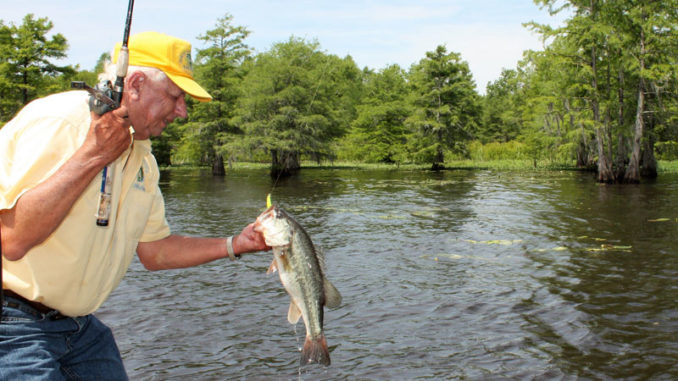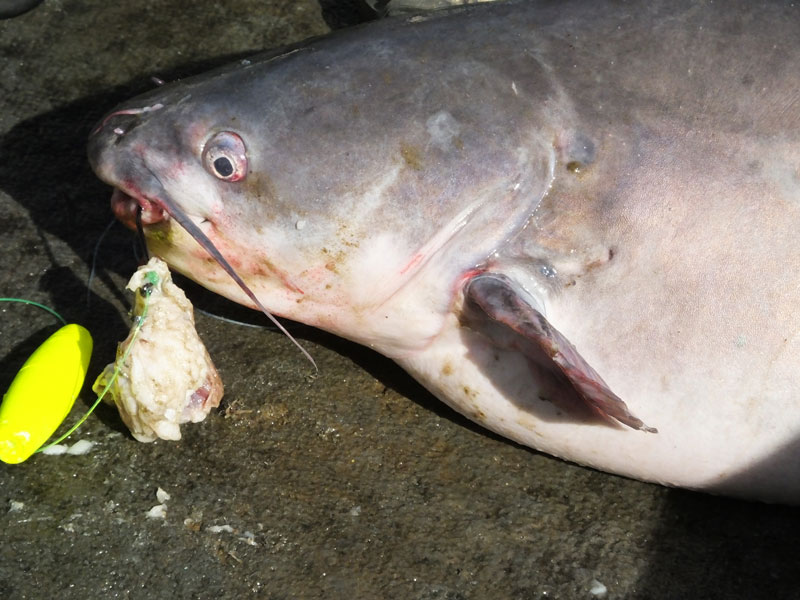
September is transition time
September is a transition month for some species in the Santee Cooper lakes. And while some patterns remain similar to the summer patterns of August, others evolve into explosive action.
One strong pattern that fishermen look forward to this month is the surface-feeding largemouth bass action.
As the annual crop of threadfin shad grows and spreads throughout the lakes, more species will begin to find and devour this abundant and highly-favored forage.
This begins an excellent stretch of bass fishing, and topwater action becomes more consistent right on through the month, typically peaking in October. When bass are aggressively smacking shad on the surface, it’s bass fishing at its finest.
Veteran guide Inky Davis from Manning said fishing patterns change for the better in September as bass begin chasing shad and schooling frequently.
“Bass make a move from dense cover to chasing forage, particularly feasting on the abundant year-class of threadfin shad,” he said. “As the shad mature, they reach a size attractive to bass. And they start moving into habitat where bass live. This activity becomes a visual advantage to fishermen in September.”
Shad on the menu
As the water cools, even slightly, Davis said shad become a prime food source. He’ll switch from focusing primarily on dense cover to working edges and isolated weeds and trees while watching, and listening, for schooling action.
Davis (803-478-7289) said while topwater action improves on actively schooling fish, topwater fishing lures are good, but not always the best choice, early in the month.
“Soft plastics continue to be productive, with a variety of lures of this type working well,” he said. “I also begin to run crankbaits and spinnerbaits frequently. They make great searching lures now that bass are more actively foraging on shad.”

Davis said that by late September, topwater lures begin to produce consistently around points, pockets and forage-packed flats.
“I’ll fish the point trees of cypress stands, especially in situations where the water depth drops from a couple feet down to 6 feet or deeper,” he said. “If the wind blows steady from a consistent direction, it can cause shad to bunch up in downwind coves and pockets. This creates an excellent situation for schooling fish or for lots of bass packed into a small area. Multiple bass can be caught quickly in this situation.”
“In addition to plastics, crankbaits and normal topwater lures, I always keep a heavy topwater and a tailspinner rigged and within reach so I can quickly cast ultra-long distances to bass schooling at my casting limit,” he said. “This usually results in a few extra bass caught during a day of fall fishing.”
Not all catfish are deep
Catfish action revs into a higher gear as September progresses and big catfish catches become more numerous. As the year-class of forage fish continues to grow and congregates into larger schools, the blue catfish in particular begin to cluster around them.
Catfish are going to be around something to eat. And as the pods of forage get into the open water areas of Lake Marion and Lake Moultrie, it gets easier to spot them on the graph at various depths. The areas where baitfish populations swell will attract catfish.
Most anglers drift using a Santee rig; cut shad, herring and white perch are excellent baits. The most-productive September depths vary with the food source in the area you’re fishing. Forage also dictates where catfish will be found. Certainly, good catches will be made in deep water this month. But not all the catfish are as deep as some fishermen believe.
Finding big pods of baitfish can be a direct link to the best depths to find catfish in the area you’re fishing. And shad will be found in multiple depths of water, often fairly shallow. Mussel beds are attractive to catfish in September, and often, the mussel beds attract catfish to feed in 10 to 20 feet of water.
Catfish action is good by day. But the nocturnal fishing can also be extremely productive. September is a great time to catch quantity and quality of catfish.
Scouting Santee stripers
Striper fishing season is closed; it re-opens on Oct. 1. Although anglers can’t keep stripers in September, it doesn’t mean those fish aren’t eating. Stripers will be mauling shad and surface schooling by late-September, and that action can be highly visible from a long distance.
If you plan to fish for stripers in early October, you can take a short break from bass, catfish or whatever species you’re targeting this month and observe where the schools are working to prep for the opening of striper fishing.





Be the first to comment